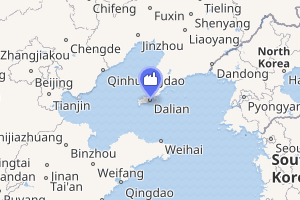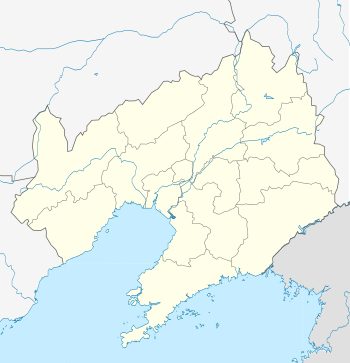Xingang Port oil spill
The Xingang Port oil spill is a spill that occurred in July 2010 caused by a rupture and subsequent explosion of two crude oil pipelines that run to an oil storage depot of the China National Petroleum Corporation in Xingang Harbour, Dalian, Liaoning Province, China. The 1,500 tonnes of oil spilled from the pipes created an 180 km2 (69 sq mi) slick in the Yellow Sea that grew to 430 km2 (170 sq mi) within a week.[3][4][5] By July 21, the spill had spread to 946 km2 (365 sq mi), and stretched as far as 90 km (56 mi) along the coast.[6]
| Xingang Port oil spill | |
|---|---|

| |
| Location | Yellow Sea, Xingang Harbour Dalian, Liaoning Province, China |
| Coordinates | 38.92°N 121.63°E |
| Date | 16–26 July 2010[1][2] |
| Cause | |
| Cause | Ruptured pipeline |
| Operator | China National Petroleum Corporation |
| Spill characteristics | |
| Volume | 1,500 to 105,000 m3 (400,000 to 27,740,000 US gal) |
| Area | >946 km2 (365 sq mi) |
Incident

The spill occurred after a process to desulfurize oil in a pipeline at the port began, triggering a fire which subsequently burned for 15 hours. The fire burned from oil that was released from a filled storage tank with a 90,000 ton capacity that collapsed as a result of the fire. Oil from other nearby tanks was, according to a Greenpeace report released several weeks after the incident, intentionally released to prevent the fire from expanding towards a tank containing dimethylbenzene, a flammable chemical.[2][7]
Containment and cover-up
Although Chinese government officials reported that as little as 1,500 tonnes of oil spilled,[2] a former University of Alaska marine conservation specialist, Rick Steiner, estimates the spill to have a much higher total, with somewhere in the range of 60,000 to 90,000 tons (18.47 to 27.70 million gallons) of oil spilled into the Yellow Sea. He said that "[i]t's enormous. That's at least as large as the official estimate of the Exxon Valdez disaster."[8][9] However, a government spokesperson for Dalian refuted this estimate, and referred to a panel of experts assessing the spill's size and environmental effect saying that "[w]e will know w[h]ether it's smaller or bigger than 60,000 tons based on the conclusion made by the panel".[10]
According to leaks on Weibo, the accident may have begun as early as June, 10. However, because the government never formally acknowledged the accident took place, as well as threatened informed citizens to delete their posts, the true nature of the accident was not clear to the public. No assessment on the effect on wildlife was ever carried out.
The ensuing fire burned for 15 hours and one firefighter drowned after being swept overboard into the water. There was extensive damage to local wildlife areas, aquaculture, and beaches were closed following the spill and conflagration which appeared to have been caused by the injection of a highly oxidizing sulfur reducing agent into a pipeline.[2]
On 26 July 2010, the Chinese local government announced the spill had been contained and that the spill had failed to reach open waters.[1] Cleanup efforts continued two weeks after the original explosion began, with operations to remove the oil performed at night when the oil is most viscous.[11]
The cleanup effort largely used low-tech methods, including containment booms and straw mats to absorb the oil, as well as a fleet of fishermen manually scooping oil out of the water and transferring it to barrels for storage and eventual disposal. Additionally, limited amounts of chemical dispersants were used, as well as a material to increase biodegradation of oil.[7]
Reaction
After the incident the Chinese government announced that safety standards would be tightened up at ports.[12]
Impact
The oil spill affected several aspects of the area's economy. Tourism was affected after oil began washing ashore on beaches, some of which were closed after the spill; according to Greenpeace, additional oil washing ashore was a possibility that remained for the rest of the summer.[7] The oil severely affected fishing industry near Dalian, especially offshore shellfish farms, many of which were contaminated by the oil, either killing the fish or rendering them unfit for consumption. The economic loss was estimated to be as high as tens of million US dollars.[7] Environmental damage was also serious as a result of the spill; the majority of wildlife inhabiting the area was exposed to oil, which led to the deaths of some, while others were expected to display longer-term effects.[7]
Lu Guang's pictures of the oil spill and the subsequent funeral of firefighter Zhang Liang were awarded a third prize in the category "Spot News" in the 2011 World Press Photo contest.[13][14][15]
See also
References
- "Dalian oil spill contained, stopped from reaching open waters: vice mayor". Xinhua News Agency. 26 July 2010. Retrieved 31 July 2010.
- Kuo, Lily (27 July 2010). "China says ocean cleared of oil 10 days after spill". Los Angeles Times. Retrieved 31 July 2010.
- Agence France-Presse (19 July 2010). "China rushes to clean up oil spill". Yahoo! News. Archived from the original on July 21, 2010. Retrieved 20 July 2010.
- "China Port Reopens After Oil Spill, Cleanup Continues". Voice of America News. 20 July 2010. Retrieved 19 July 2010.
- The Associated Press (21 July 2010). "China Oil Spill Grows, Official Warns Of 'Severe Threat'". The Huffington Post. Retrieved 21 July 2010.
- Agence France-Presse (22 July 2010). "Clean-up crews use bare hands against China oil spill". Yahoo! News. Archived from the original on July 24, 2010. Retrieved 22 July 2010.
- "Dalian Oil Spill: Preliminary Findings and Recommendations". Greenpeace. 2 August 2010. Archived from the original on August 5, 2010. Retrieved 10 August 2010.
- Associated Press (30 July 2010). "US expert: China oil spill far bigger than stated". Yahoo! News. Archived from the original on August 1, 2010. Retrieved 30 July 2010.
- The Associated Press (30 July 2010). "China Oil Spill Far Bigger Than Stated, U.S. Expert Says". The Huffington Post. Retrieved 31 July 2010.
- Huang, Jingjing (August 3, 2010). "Dalian official refutes Greenpeace allegations about impact of spill". Global Times China Society. Archived from the original on August 6, 2010. Retrieved 3 August 2010.
- Hogg, Chris (30 July 2010). "China struggles to recover from 'worst ever' oil spill". BBC News. Retrieved 31 July 2010.
- "China orders ports to enhance safety after Dalian pipeline accident". Xinhua. 23 July 2010. Retrieved 31 July 2010.
- Jess Miller: "Dalian oil spill photographer receives award at World Press Photo," Greenpeace News, 8 May 2011.
- World Press Photo: 2011 Photo Contest.
- World Press Photo: Lu Guang - 2011 Photo Contest.
External links
| Wikinews has related news: |
- Oil spill in Dalian, China, The Big Picture
- The Value of Ethical Oil The Source with Ezra Levant - April 20, 2011